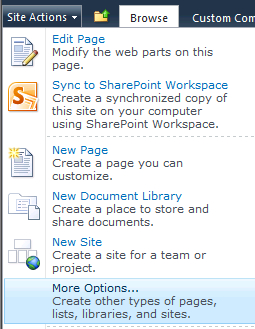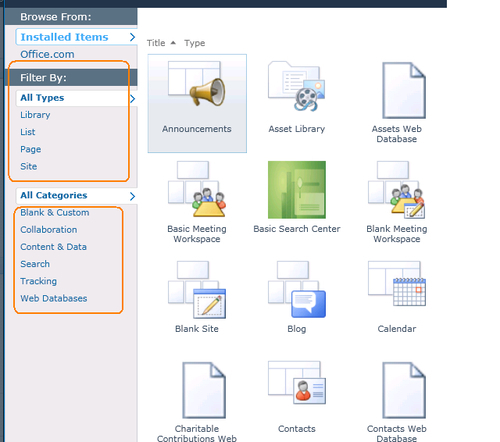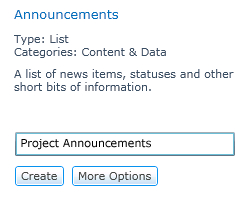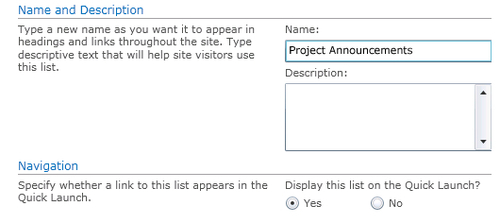To create a list, click on Site Actions | More Options…:

You will be presented with a series of out of the box List templates, each of which has a slightly different column names and views, but they all have the common List functionality.
There is the ability to filter the displayed List templates with the navigational menu on the left-hand side.

Once you have chosen your List, type in the List name and URL, and the List will be created.

Tip
As best practice, avoid putting spaces in the name as shown in the preceding screenshot. Otherwise, this puts the %20 character in the actual URL of the list. For example, in the preceding screenshot, the generated SharePoint list URL would be /Lists/Project%20Annoucements/AllItems.aspx. SharePoint converts non-alphanumeric characters to URL-friendly characters. This whitespace can cause problems when the URL is being used with workflows or being pasted by a user into an e-mail as the URL may be truncated when the e-mail has been sent.
Once a list or library has been created, the URL cannot be changed. You can always change the name and put in spaces in the name from the List settings.
In the preceding screenshot, you can select More Options... to add a description to the list, or add the list to the Quick Launch navigation of the Site.

Once a List is created, you will be automatically directed to the newly created list.
The SharePoint installation has provided many out of the box List Templates that are predefined, and will generally meet your needs with perhaps some minor enhancements by adding a few extra fields.
It is beyond the scope of this book to cover each list template in detail as we believe that it is more productive for you to experiment and create lists yourself and learn the functionality they provide.
For team collaboration, the out of the box list templates such as the Calendar and Discussion List Templates are available in most Site Templates and should be sufficient for your requirements.
Tip
The Team Site template will probably meet most of your collaboration requirements as this site template has Shared Documents, Issue Tracking, Discussions and Announcements Lists, and Libraries.
As you architect a SharePoint deployment, it is important to know which List templates are available on which sites as this can affect deployment timelines. Take a look at the table in Appendix B, SharePoint Functionality Comparison, which illustrates the list templates that you are most likely to use on a day-to-day basis.
As your collaboration needs become more sophisticated and you become more familiar with SharePoint's functionality and user requirements, it is worth reviewing the following List Templates as these have specific functionality.
When you are creating a list, its description is displayed on the top right-hand side of the page when the list icon is selected. This is a good way to learn the functionality of the available lists.

In this section, the less intuitive functionality of lists is explained.
This is a new list to SharePoint 2010 and is used to display Line of Business (LOB) data from an SQL database. We view this provided functionality as beyond end user activity as you will need to have knowledge of SharePoint Designer or Visual Studio to configure this kind of List to show data.
This is a blank list with no fields or views. Use this list template if none of the built-in features of a list meet your criteria.
When this list is created, the columns and data from a spreadsheet are copied into it. The data import process from the spreadsheet only occurs when the list is created. Choose this list if you are migrating content from a spreadsheet into a list and all future data activity is intended to be performed in the SharePoint list.
This is a calendar list of events. It is not a calendar of an individual's Outlook calendar, but a calendar that displays date values of a list. Typically, this type of list is used as a team calendar to track meeting dates or as a resource booking tool like a conference room or overhead projector. A typical business scenario of a calendar list could be for resource booking requests that require an approval process. Custom fields can be added to the list such as department and resource. With this business scenario, there can be a view to display categorized departments and a sub category of the requested resource, so there is the ability to identify which departments are making the requests and for what resources.
An advantage a calendar list has over an Outlook calendar is that different views can be created to show list items in different formats. The calendar list can also be synchronized into Outlook. This functionality is covered in more detail in Chapter 7, Office Integration with SharePoint. This list has calendar-formatted views.
